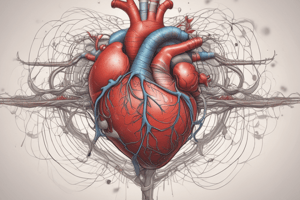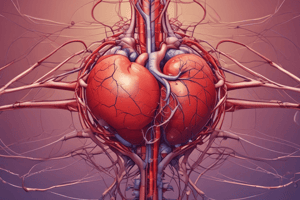Podcast
Questions and Answers
How many times does an average human heart contract in a year?
How many times does an average human heart contract in a year?
- 3 billion times (correct)
- 39 million times
- 39 billion times
- 108,000 times
Where is the apex of the heart located?
Where is the apex of the heart located?
- At the third costal cartilage
- In the mediastinum near the sternum
- Near the junction of the fourth and fifth ribs (correct)
- In the pericardial cavity
What structure separates the heart from other mediastinal structures?
What structure separates the heart from other mediastinal structures?
- Pericardium (correct)
- Thoracic cavity wall
- Pericardial cavity
- Surrounding lungs
Which surface of the heart is referred to as the base?
Which surface of the heart is referred to as the base?
What is the anatomical position of the heart within the thoracic cavity?
What is the anatomical position of the heart within the thoracic cavity?
What shape is the heart typically compared to?
What shape is the heart typically compared to?
What is the significance of the cardiac notch?
What is the significance of the cardiac notch?
Why is it important to understand the orientation of the heart?
Why is it important to understand the orientation of the heart?
What is the approximate weight range of a female heart?
What is the approximate weight range of a female heart?
What physiological change occurs in cardiac muscle as a result of exercise?
What physiological change occurs in cardiac muscle as a result of exercise?
What are the primary pumping chambers of the heart?
What are the primary pumping chambers of the heart?
Which circuit of the circulatory system is responsible for transporting blood to the lungs?
Which circuit of the circulatory system is responsible for transporting blood to the lungs?
What can cause an enlarged heart muscle besides exercise?
What can cause an enlarged heart muscle besides exercise?
Which chamber of the heart receives deoxygenated blood from the body?
Which chamber of the heart receives deoxygenated blood from the body?
What is the approximate size of a typical human heart?
What is the approximate size of a typical human heart?
What is a common consequence of hypertrophic cardiomyopathy?
What is a common consequence of hypertrophic cardiomyopathy?
Flashcards are hidden until you start studying
Study Notes
Heart Function and Significance
- The average human heart contracts about 75 times per minute, totaling approximately 108,000 contractions daily and nearly 3 billion over a 75-year lifespan.
- Vital role of the heart in circulation emphasizes its importance to overall health.
Heart Location and Structure
- The heart is situated in the thoracic cavity, specifically within the mediastinum, between the lungs.
- It is encased in a tough membrane known as the pericardium and sits in the pericardial cavity.
- The heart’s dorsal surface is adjacent to the vertebrae, while the anterior surface lies behind the sternum.
Heart Orientation
- The base of the heart, where major veins and arteries attach, is situated at the level of the third costal cartilage.
- The apex is positioned to the left of the sternum, between the fourth and fifth ribs.
- The leftward deviation of the apex creates a cardiac notch in the left lung's superior lobe.
Heart Dimensions and Weight
- A typical heart measures roughly the size of a fist: around 12 cm in length, 8 cm wide, and 6 cm thick.
- Female hearts weigh approximately 250-300 grams, while male hearts weigh around 300-350 grams.
- The hearts of well-trained athletes tend to be larger, improving blood pumping efficiency.
Cardiac Muscle and Exercise
- Exercise leads to cardiac hypertrophy, increasing the size of individual muscle cells without growing their numbers.
- Hypertrophic cardiomyopathy can cause an enlarged heart due to pathological changes, often undiagnosed, potentially leading to sudden death in young individuals.
Heart Chambers and Circulation
- The human heart contains four chambers: right atrium, left atrium, right ventricle, and left ventricle.
- Atria receive blood, pushing it into the ventricles, which serve as the primary pumping chambers.
- The pulmonary circuit transports blood to and from the lungs for oxygenation and carbon dioxide removal.
- The systemic circuit delivers oxygenated blood to tissues and returns deoxygenated blood to the heart.
Studying That Suits You
Use AI to generate personalized quizzes and flashcards to suit your learning preferences.




